There is almost a no better way to recycle food scraps and yard waste than to place them in a compost bin. With enough time, patience, and a little care, all those microorganisms will turn those worthless scraps into the rich black gold all gardeners love. For most composters, the EPA states, “most compost is ready in 2-5 weeks.”
Whether you’re trying to go full zero-waste or be a little more eco-friendly, a compost bin can be one of the first steps to reducing your carbon footprint. You’re helping to keep excess waste from ending up in landfills and giving all the plants in your garden a nutrient-rich boost of all sorts of vitamins in minerals to help keep them strong and healthy.
If you haven’t read our guide on how to make compost, it’s worth the read. In this guide, you’ll learn everything you need to get started composting. Additionally, if you’re looking to start using worms, our vermicomposting guide provides all the info you need to know!
At the bottom of this list is our compost bin buying guide, which if you do not know anything about compost bins is a great place to start.
Compost Bin Buying Guide
Getting started composting doesn’t have to be complicated! Sure, if you begin browsing online, you’ll probably see a million different options. Rolling compost bins, worm bins, kitchen counter models, and more. With all these decisions, it can get overwhelming, but we hope to help with this guide that will break down all the different types.
So please, read through this guide and then check out the section above that will help you select the compost bin that is right for your situation. The benefits of composting are virtually endless and you’ll be helping the environment too!
Types
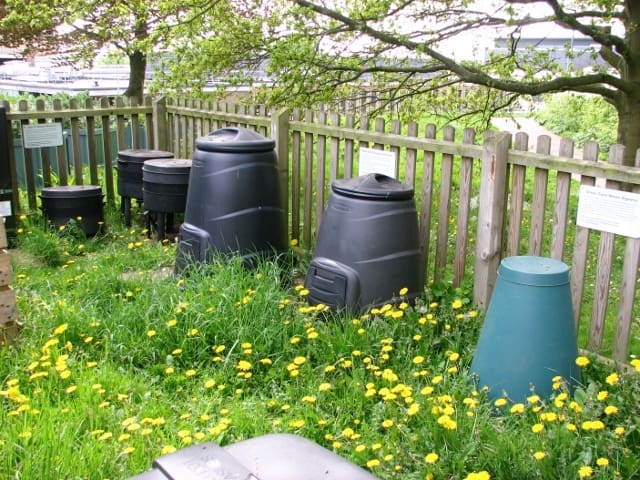
Generally, there are several different types of compost bins, and the categories overlap just a bit. There are bins meant explicitly for outdoors, while there are others for indoors or both! Then you can get a little more specific with bins that will tumble or utilize worms to speed up the breakdown of organic materials. You can get as basic or as fancy as you want with these bins.
Outdoor Compost Bins
When people think of a compost bin, a large open-air structure is usually what comes to mind. Fortunately, there are plenty of other options, large, small, fast, slow, and everything in between. For these bins, you generally need four things besides the compost, airflow, movement, heat, and moisture. These are the four necessities for creating that nutrient-rich black gold you desire.
The Compost Pile – A Poor Man’s Compost Bin
If you want to get started composting and don’t have any cash, the easiest way is to start a pile in your backyard. Designate an area, preferably a far distance away from your home, and dispose of kitchen scraps and other organic materials there.
You may even dig into a slight depression if you wish. Just make sure you know what you can put in your compost pile, and call 811 before digging, so you don’t hit a line.
Basic Outdoor Compost Bin
You can build a DIY Compost Bin out of 2×4’s or wooden pallets in a weekend with basic hand tools, or purchase one for about $35.
Your DIY compost bin is essentially a big box where you can layer the materials however you please. You’ll have to do some maintenance such as moving or ‘fluffing’ the pile from time to time, but it’s cheap, and it works. Most people may opt for the GEOBIN, for non-food items like grass clippings, leaves, mulch, etc.
Tumbler Outdoor Compost Bin
A rotating, also known as a rolling or tumbler compost bin is one that is usually cylindrical and on a wheeled frame. These bins are generally the fastest and easiest to use; however, they have a lower capacity and cost a little bit more. As mentioned earlier, compost needs air, movement, heat, and moisture.
A rotating bin makes it easy to rotate the compost and allows air to flow between the materials and provides oxygen to break down the organic material faster.
Secondly, being a self-contained unit that usually is a darker color, these bins can heat up to much higher temperatures, further speeding up the composting process. Heat gets trapped in the material and the container, so even when the temperature may drop, your compost will stay warm longer.
Worm Composting Bins
Composting with worms, technically known as vermicomposting, is a very efficient way of creating rich compost, fast. Vermicomposting isn’t for beginners, as you can run into several different problems with a worm compost bin that can easily overwhelm the newbie.
How worm composting works is something like this: you have a base layer of scraps and worms, as the worms’ transform’ those scraps into compost you’ll remove that finished compost and add a layer of scraps on top. The worms will migrate their way to the next layer, and the cycle continues again, giving you a new round of compost in a relatively short amount of time.
Vermicomposting is done indoors and outdoors. If you’re doing it indoors, most people prefer to keep their worms in the basement or at least under the counter. Remember to watch the health of your worms, and the moisture levels, and regularly add scraps for them to eat. It’s a lot of work, but it’s one of the most efficient composting methods out there!
Continuous Flow Compost Bins
These are similar to your basic compost bins mentioned earlier in this post, but with one big difference. A continuous compost bin allows you to regularly add fresh materials to the top and remove freshly transformed compost from the bottom.
Many models look like modern trash cans and would blend in very easily with other outdoor items. These bins are often equipped with rotators to aid in movement and latched doors that prevent unwanted critters from getting into your bin.
Indoor Compost Bins
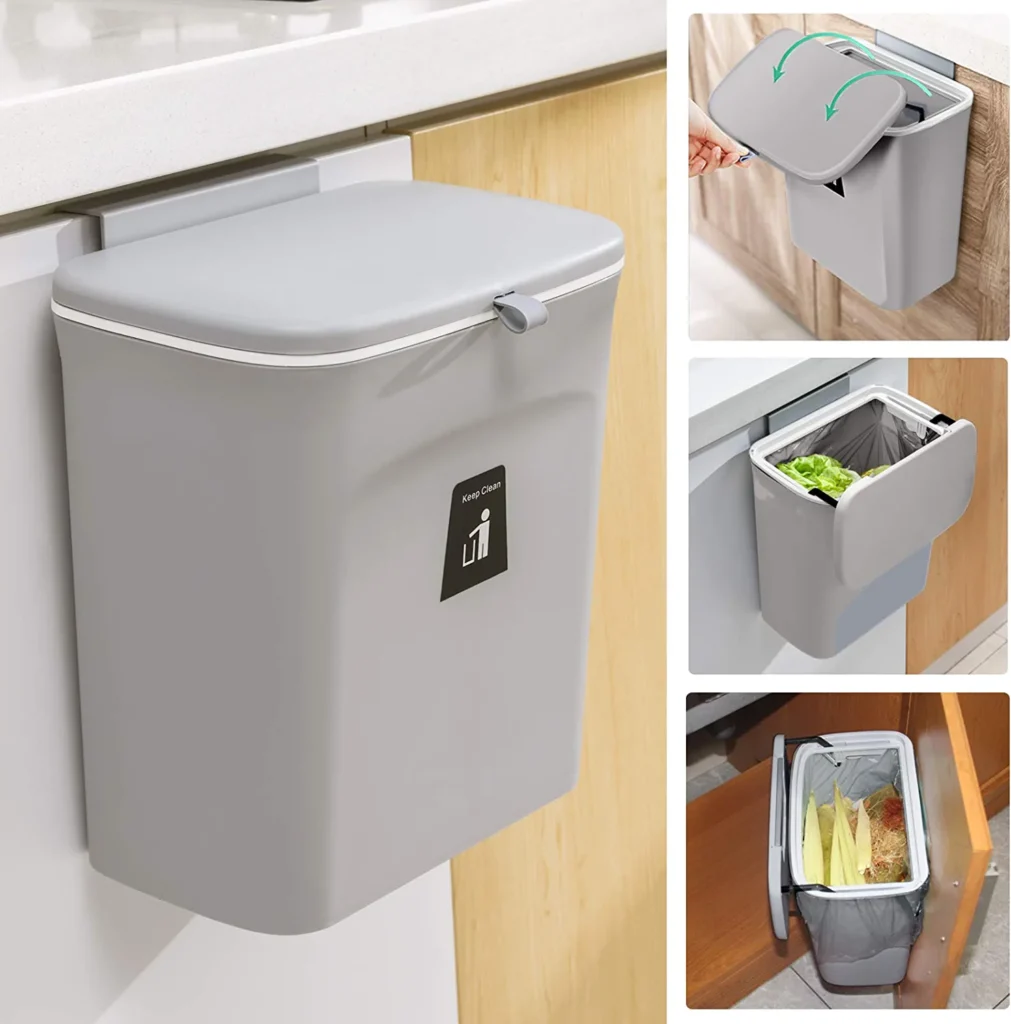
Indoor compost bins are perfect for city dwellers who might live in an apartment or don’t have access to a yard. These kitchen top or under the sink options are great for small quantities that will help you make compost for a smaller garden or houseplants.
Countertop Compost Bin
As the name implies, these compost bins are perfect for sitting on your counter or under the sink. A medium-sized bin allows you to cut down on the number of trips to your backyard or basement. These bins are small and meant for vegetable or fruit scraps, used coffee beans, eggshells, and other things of that nature.
Trash Can Compost Bin
Again, as the name implies, these compost bins are going to be about the size of a trash can and are bigger versions of the countertop models mentioned above. For a family of 4 or more, this is the size you’ll most likely want. You may see some indoor bins utilize bokashi, which is essentially a different means of adding nutrients to the soil, different from traditional composting. More on Bokashi Composting can be found here.
Features To Consider: Compost Tumblers vs. Compost Bins
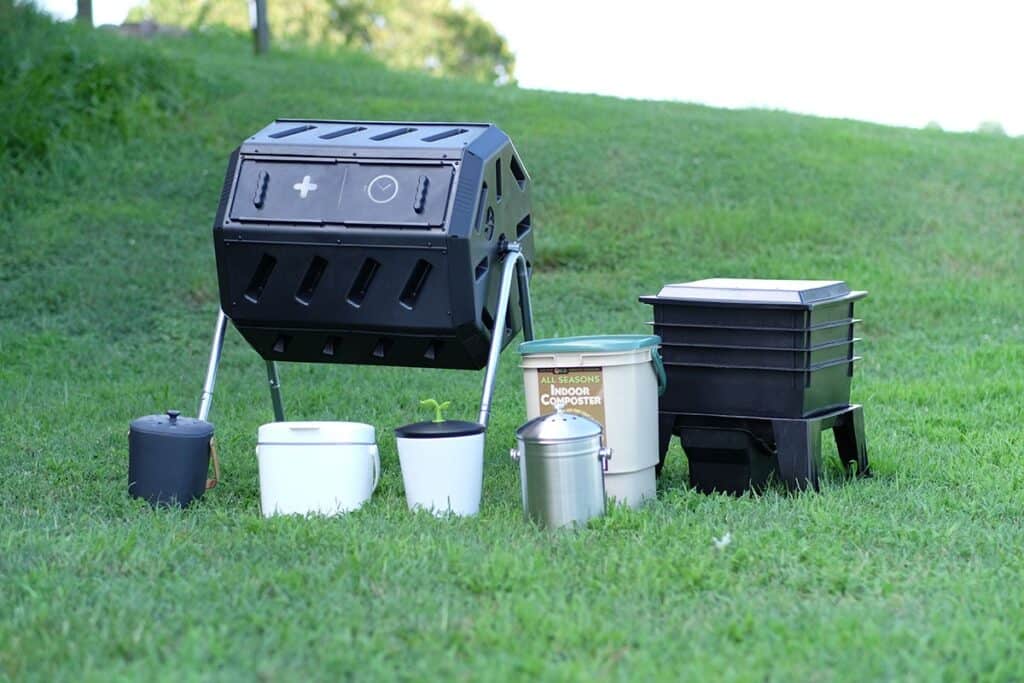
There isn’t a difference in terms of the result they produce. With a regular stationary bin, it takes around 12 weeks or more for compost to fully form depending on the size of the bin and other factors. With a tumbler, this time is typically reduced to around 6 to 8 weeks, dependent on the size of the load, and other factors.
The biggest difference is the amount of work you’ll end up putting in over 6 to 12 weeks. With a regular bin, the material needs routine aeration to properly breakdown.
Aeration is typically done at least once or twice a week. With a bin, you’ll either need to use a pitchfork or aerator to move the pile around. Aerating will take you about 5 to 10 minutes. With a tumbler, it’ll only take you 30 seconds or less to give those microbes all the oxygen they’ll need for the week. It’s incredibly easy to walk up, and rotate the tumbler back and forth a couple of times and that’s it.
Materials
The composition of the bin rarely, if ever, affects the outcome of the compost. The makeup of your bin is most heavily related to cost and appearance. If you can get wooden pallets for free and don’t mind doing a little DIY work, you can make a very lovely-looking bin with a little bit of elbow grease.
On the other hand, using chicken wire and a couple of stakes is a very cost-effective way to get a custom size compost bin up quickly. Lots of different manufacturers offer various plastic options with everything from post-consumer recycled plastic to resins and polyethylene. The options are almost endless.
In terms of durability, it depends heavily on your climate. Most indoor bins will last forever as long as you don’t abuse them and clean them from time to time. Outdoor containers are a different story since they’re subject to the elements, animals, and children.
A large plastic, locking bin may be your best option if you’re worried about animals or children. Animals will have a difficult time getting into the bin, and most plastic bins won’t have any sharp points or corners that pose a hazard to children.
Take into consideration some more of the features below for a better idea of what’s out there!
Bear Proof
Okay maybe “Bear Proof” is a little over the top, but you want to have a bin that’s difficult for animals to open. A hungry raccoon might find its way into your yard and could end up eating all the nutrient-rich greens you layered in your bin. Not to mention the animals might go looking for other late-night options in your regular trash or recycling.
Odor-Resistant
This feature is specific to indoor compost bins. If the smell of rotting fruits and vegetables doesn’t sound appealing to you, you’ll want to make sure your bin is equipped with a charcoal carbon filter. What it does is allows air to leave the bin, but not the bad smells that come with it. These filters are replaceable, but will usually last for 4-6 months before needing to be replaced. They’re inexpensive and easy to replace.
Transportability
This only matters with outdoor bins, since an indoor compost bin can be easily moved. You might be thinking, “Why would I need to move my compost bin?” A very valid question. The only reason you would want a bin on wheels or one that rolls is if you are moving a substantial amount of compost or you’ll be spreading it to large areas of your lawn.
Remember there’s a lot of moisture in fresh compost so hauling it around without wheels can be a difficult job, especially if you have a large area to cover. That distance is twice is bad if you are making several trips to and from where your bin remains put.
Air Vents
Rolling compost bins generally don’t have air vents. This design is because the rolling and tumbling action introduces fresh oxygen into the decomposition process. Bins that do not tumble need to have some ventilation that brings air into the mix to allow the microbes to break down the organic matter.
This is why you’ll see virtually every single DIY compost bin design has either wire or just open space on the sides. Chicken wire is a fan favorite since it maximizes the amount of air that can reach the pile. Whether you opt for a non-rolling bin with or without sufficient air circulation, you’ll want to fluff and rotate the collection at least once a week.
Multiple Chamber Bins
For the experienced gardener, multiple chamber bins offer you the ability to separate different materials based on each heap’s stage of decomposition.
For example, some composters may opt to keep their yard waste separate from kitchen waste. Others may wish to use bin one for fresh compost, bin two as a decomposition holder, and bin three as storage for ready-to-use compost. By doing this, they avoid slowing the breakdown of a first layer by moving it to the second bin when they have more material to add.
Size and Capacity
Buying the biggest bin might seem like the best option from the start, but be sure to consider how much compost you’ll use the amount of work you’ll need to do, and the amount of waste that you will need to put in it.
While having too much space is rarely an issue, having too little space can be. The mixture needs air to break down; therefore, there needs to be ample room for the compost to move. Buy the largest you can afford and then upgrade as you find it necessary.
Shape and Color
Almost all compost bins bought online will come in either a square or cylindrical shape. Square compost bins will fit together more easily if you have multiple ones, but the corners make it difficult to stir the mixture and allow air into the mix.
A cylindrical bin is easier to mix, although you do lose some usable space when putting multiple ones side by side. You might find some bins in an octagonal shape, or if you build your own, you can make them into whatever form you want.
Composting is an exothermic reaction, meaning it generates its own heat as the materials in the mixture break down. So even if you do choose a pink compost bin, it’s not going to matter a whole lot. Most people tend to stick with black or dark green, not only because it blends in well with the rest of the landscape, but the darker color absorbs more sunlight. This raises the internal temperature of the bin, promoting a faster breakdown of materials.
What Factors Really Matter?
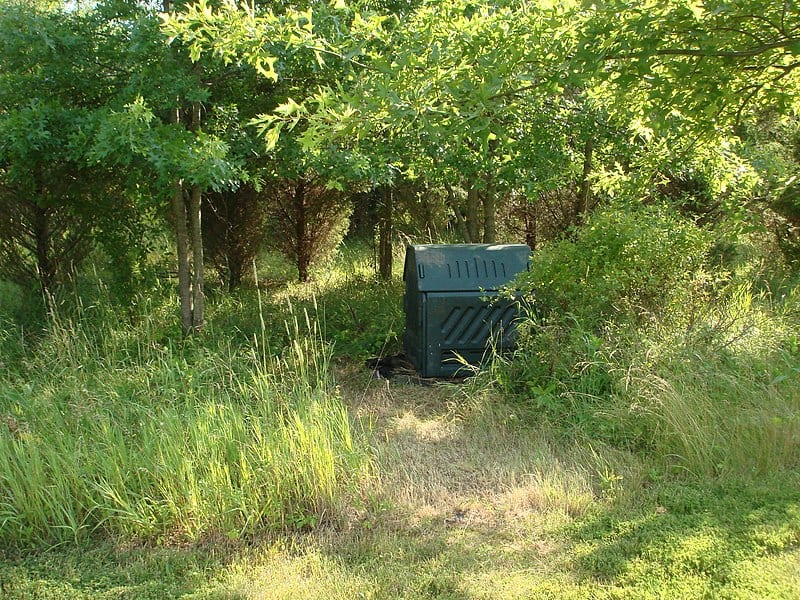
For someone new to composting and wants to get started, ask yourself these three questions. One, how much will I realistically put in the bin? Two, where should I put the bin? And three, how much time do I have to take care of the mix?
How Much Can I Put in My Compost Bin?
Bin volume depends entirely on your cooking and lawn care habits. If you’re not entirely sure of everything you can put in a compost bin, see this list here. That list will give you a better idea of things you already throw in the trash that could be diverted to a compost bin. Generally speaking any vegetable or fruit scraps, eggshells, and coffee grounds can be put in a compost bin. No meat or dairy products should be used.
Where Should I Put a Compost Bin?
If you’re placing your compost bin indoors, this is easy to answer – usually under the sink, on the counter, or sometimes in the basement. The question becomes a little more complex going outside.
You’ll want to place the bin far enough away from the house so that if an animal does become curious, it doesn’t wander around your other trash or up onto your back porch. Additionally, you’ll want to have the bin in an area that receives a fair amount of sunlight so it can receive additional heat. You may even consider re-planning other areas of your yard, so the distance from your compost to its intended destination is shorter and requires less walking.
How Much Time Do I Have to Take Care of the Mix?
In reality, you could throw everything into a pile, and eventually, it will turn into compost. By the time that happens, you’ll probably have forgotten you even started a compost pile! Whether a bin or a tumbler, you’ll want to give the mix a good fluffing at least once a week.
As mentioned earlier, for a tumbler, that takes all of 40 seconds. For a pile or bin, you’ll need to get an aerator, or use a pitchfork and fluff the pile manually. While it’s not strenuous, it can be annoying having to get those tools out of the garage and spend 10 minutes fluffing decomposing matter.
How to Get Started Composting?
Start by purchasing one of our favorite compost bins above or by reading some more articles below. After going through these, you’ll have an idea of the items you can put in your compost bin and decide whether or not you want to buy one, or build one. There are plenty of reviews included for some popular models listed on Amazon and other sites.
Best Compost Bins
Best Countertop Compost Bin: Chef’n EcoCrock Counter Compost Bin
For those with few scraps, or just getting started composting, the EcoCrock countertop compost bin offered by Chef’n is the perfect kitchen solution. Unlike other countertop bins, this model’s base material is ceramic, a more modern and stylish design than its metal trash-can style counterparts.
Apart from its tasteful appearance, the bin’s capacity comes in at 75 US gallons and has a removable inner pail that makes it easy to transfer scraps from the ceramic base.
Modern 3 liter (0.75 gallon) ceramic countertop compost bin, featuring a vented lid, removable inner bucket, and a replaceable natural charcoal filter that traps and absorbs odors.
Best Indoor Kitchen Compost Bin: YukChuk 1.5 gal Compost Container System
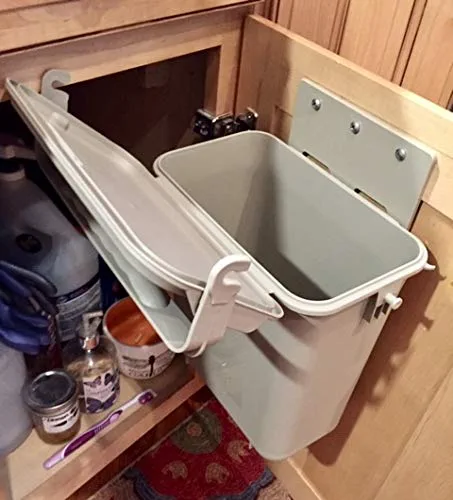
This 1.5 US gallon compost bin is the perfect under-counter solution for the environmentally conscious home or apartment owner. No need to replace any carbon filters to prevent smell, this bin is odor-free by design. The rubberized O-ring around the rim locks in odors and prevents any pesky fruit flies from finding a new home.
Along with a mounting kit, you can attach this to the door under your sink, keeping the bin out of sight, yet easily accessible. A built-in handle makes it convenient and easy to move your compost scraps to a larger container or your garden outside.
YukChuk raises the bar for Kitchen Food Waste Collection in our Compost Pail with Patent Pending design.
Best Worm Compost Bin: Worm Factory 360 Vermicomposting Container System
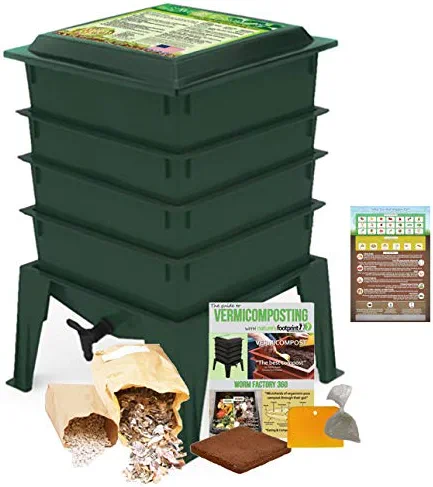
The Worm Factory 360 is tough to beat in terms of value and scalability. The package comes with four stackable bins, with the ability to add up to 4 more for a total of 8. A ‘worm tea’ collector tray at the bottom makes it easy to harvest the compost juices that can be fed to your lawn or garden to encourage healthy growth.
You can use as few or as many bins as you want. Just because it’s meant for worms, doesn’t mean you have to start using them right away. If you think you might get into vermicomposting later, this option is a great ‘starter kit’ in general for composting.
The Worm Factory 360 has a standard 4-Tray size which is expandable up to 8 trays, giving it the largest volume of any home composter.
Best Compost Tumbler Bin: EnviroCycle Composting Tumbler Bin
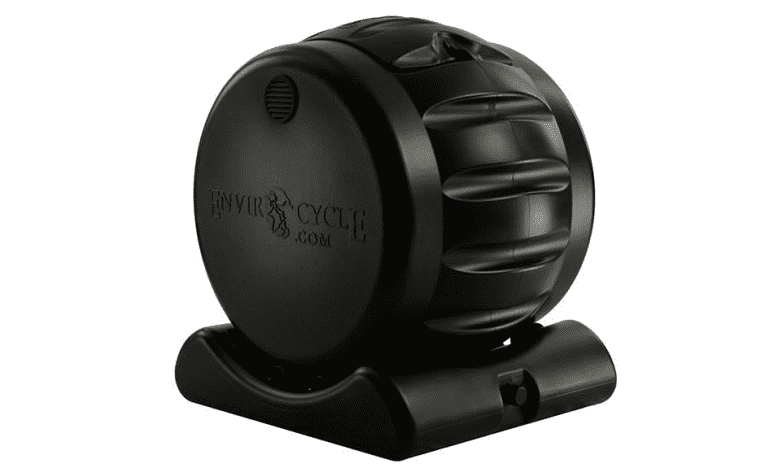
The EnviroCycle is the premium option when it comes to rolling or tumbling compost bins. Overall, the design is fantastic. The tumbler is manufactured in the USA with food-safe, BPA-free, and UV-resistant materials. No assembly is required, and rotating the bin is as easy as giving it a firm push since it sits on a ball-bearing frame.
The frame containing the ball bearings acts as a storage for the nutrient-rich compost tea that drains off. Given its low profile, this tumbler stays out of sight and blends in well with the rest of your yard or garden.
This distinctive 2 in 1 compost tumbler makes it easier and faster to generate nutrient rich compost year round.








